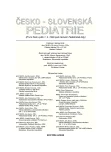Snoring and Obstruction Sleep Apnea at the Child Age from the Otolaryngologist Point of View
Authors:
T. Pniak 1; Pavel Komínek 1
; V. Novák 2
Authors‘ workplace:
Otorinolaryngologická klinika, FN Ostrava, Ostrava-Poruba
prednosta doc. MUDr. P. Komínek, Ph. D., MBA
1; Klinika dětské neurologie, FN Ostrava, Ostrava-Poruba
prednostka MUDr. M. Kunčíková
2
Published in:
Čes-slov Pediat 2009; 64 (12): 653-659.
Category:
Review
Overview
The most common sleeping disorders in childhood are:
simple snoring, Upper Airway Resistance Syndrome (UARS) and Obstructive Sleep Apnea (OSA), the last one affecting 1–3% of children. They are usually caused by adenoid vegetation and tonsillar hypertrophy, which are found by endoscopic ENT examination. In cases of obstructed rhinopharynx and oropharynx, adenoidectomy and tonsillectomy (tonsillotomy) are recommended.
Children with craniofacial and neurological abnormalities suffering from OSA, as well as children with unclear clinical findings, are referred for examination in the Sleep Laboratory to establish fast diagnosis and an early treatment. Such strategy helps to prevent the development of neurocognitive deficit, growth disorders and other associated consequences of fragmented sleep. We present a 13-year old patient, referred and admitted to our hospital for a long-lasting snoring. She was diagnosed with adenoid vegetation, tonsillar hypertrophy and a mild form of OSA, with AHI (apnoa/hypopnea index) of 8.5. Following successful adenoidectomy and tonsillotomy, the patient recovered and presently is without sequellae with normal levels of apnea/hypopnea confirmed by polygraphic examination.
Key words:
snoring, obstructive sleep apnea, adenoid vegetation, adenoidectomy, tonsillectomy
Sources
1. Jakubíková J. Chrápanie u detí. Martin: Neografia, 2000 : 11–56.
2. Marcus C. Sleep-disordered breathing in children. Current Option in Pediatrics 2000;12 : 208–212.
3. Šonka K, et al. Apnoe a další poruchy dýchání ve spánku. 1. vyd. Praha: Grada, 2004 : 209–223.
4. Nevšímalová S, Šonka K. Poruchy spánku a bdění. 2. vyd. Praha: Galén, 2007 : 151–234.
5. Bower Ch, Buckmiller L. What’s new in pediatric obstructive sleep apnea. Current Opinion in Otorinolaryngology & Head and Neck Surgery 2001;9 : 352–358.
6. Chan J, Edman J, Koltai P. Obstructive sleep apnea in children. American Family Physician 2004;5 : 1147–1154.
7. Peeke K, Hershberger M, Marriner J. Obstructive sleep apnea syndrome in children. Pediatric Nursing 2006;5 : 489–494.
8. Komínek P, Chrobok V, Astl J, a kol. Záněty hltanu. Havlíčkův Brod: Tobiáš, 2005 : 120–207.
9. Mindell J, Owens J. A Clinical Guide to Pediatric Sleep: Diagnosis and Management of Sleep Problems. 1st ed. Philadelphia: Lippincot Williams & Wilkins, 2003 : 107–121
10. American Sleep Disorders Association: The International Classification of Sleep Disorders: Diagnostic and Coding Manual. 2nd ed. Westchester: American Academy of Sleep Medicine, 2005 : 56–59.
11. Demain J, Goetz D. Pediatric adenoidal hypertrophy and nasal airway obstruction. reduction with aqueous nasal beclomethasone. Pediatrics 1995;95 : 355–364.
12. Li K, Riley R, Guilleminault C. An unreported risk in the use of home nasal continuous positive airway pressure and home nasal ventilation in children: mid face hypoplasia. Chest 2000;117 : 916–918.
13. Hultcrantz E, Linder A, Markstorm A. Tonsillectomy or tonsillotomy? A randomised study comparing postoperative pain and long-term effects. Int. J. Pediatr. Otorinolaryngol. 1999;51 : 171–176.
14. Friedman N. Polysomnography should not be required both before and after adenotonsilectomy for childhood sleep disordered breathing. Journal of Clinical Sleep Medicine 2007;7 : 678–680.
15. De la Chaux R, Klemens C, Patscheider M, et al. Tonsillotomy in the treatement of the obstructive sleep apnea syndrome in children: polysomnographic results. Int. J. Pediatr. Otorhinolaryngol. 2008;9 : 1411–1417.
Labels
Neonatology Paediatrics General practitioner for children and adolescentsArticle was published in
Czech-Slovak Pediatrics

2009 Issue 12
- What Effect Can Be Expected from Limosilactobacillus reuteri in Mucositis and Peri-Implantitis?
- The Importance of Limosilactobacillus reuteri in Administration to Diabetics with Gingivitis
Most read in this issue
- Snoring and Obstruction Sleep Apnea at the Child Age from the Otolaryngologist Point of View
- Preventive Intervention Programs in the Area of Healthy Nutrition for Children – the Projects of the World Health Organization to Fight Children Obesity
- Lung Injury Caused by Incorrect Strategies of Mechanical Lung Ventilation in Experimental Study
- Probiotic Bacteria in Human Breast Milk – Myth or Reality?
